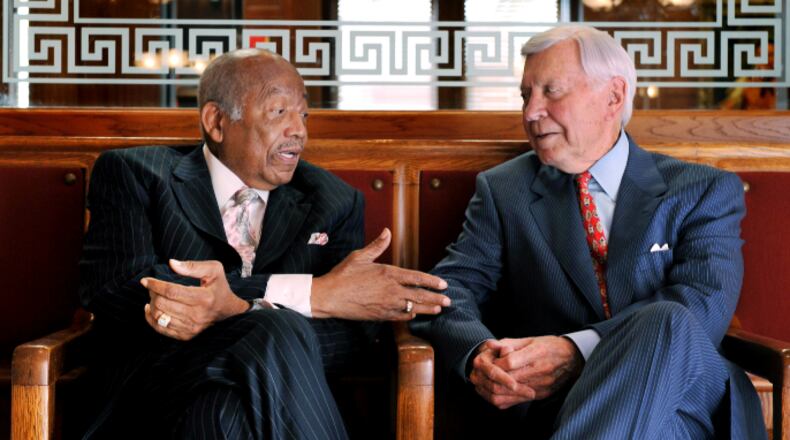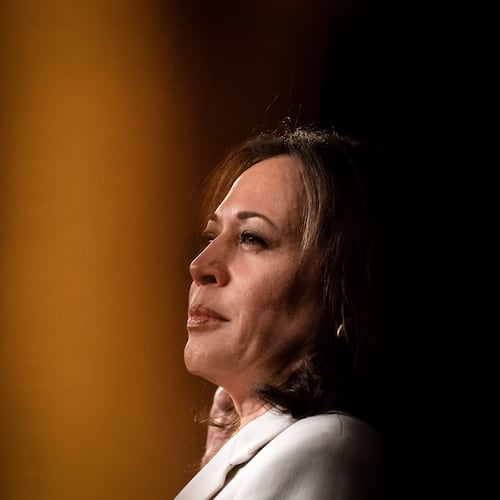Former state Sen. Leroy Johnson of Atlanta, who in 1962 became the first black Georgia senator elected since Reconstruction, has died. He was 91.
My AJC colleague Maya Prabhu will be updating details here. But below is a 2008 piece I wrote on how Johnson, upon his election, formed a partnership with the likewise newly elected Gov. Carl Sanders to desegregate the state Capitol. Sanders died in 2014:
***
Over the past several years, the state Capitol has earned a reputation for very loud fights over very small things.
It wasn't always so. Once upon a time, Jericho-sized walls came tumbling down under the Gold Dome, and without the bleat of a single trumpet, much less a press conference.
Worlds were overthrown with a minimum of fuss. Revolutions required 15 minutes, a quiet phone call or two, and a certain sense of right and wrong.
Last year, Senate President pro tem Eric Johnson (R-Savannah) began an oral history program, recording interviews with past political figures of Georgia and posting the video on the Internet.
Former Gov. Carl Sanders, now 82, was added just a few days ago. He'd been preceded by state Sen. Leroy Johnson, the first black lawmaker elected since the days of Reconstruction. He's 79.
Without coordination or prompting, both men --- each interviewed by Eric Johnson --- tell the same, little-known tale of the day 45 years ago that desegregation came to the Capitol.
In January 1963, the seat of state government, like the rest of Georgia, was divided not so neatly into black and white.
Restrooms and drinking fountains were labeled "white" and "colored." The galleries perched above the House and Senate chambers were likewise segregated. The army of young pages who delivered messages to lawmakers was uniformly pale. A driver's license office in the basement had two separate lines.
Into this hostile world walked 34-year-old Leroy Johnson, a Morehouse graduate forced to study law in North Carolina because "the University of Georgia was not accepting Negroes."
For most of the session, Johnson's days were spent in silence. "Not one senator spoke to me," he said.
Sanders, who had likewise just begun his term, was watching Johnson closely. "He could have been a pain in the neck, as far as I was concerned," the former governor remembered.
With little else within reach, Johnson's objective became the desegregation of the state Capitol. The question was how to go about it.
Given the combustible environment --- only months later nearby Birmingham would point fire hoses and police dogs at protesters --- Johnson judged that it was better to make a point than a scene. It took him three weeks to recruit his first black pages, and then he started.
"I carried my pages into restrooms that said 'white' instead of 'colored.' And when we got to the water fountain, I had them drink from the water fountain that had the sign that said 'white' instead of 'colored,' " he said.
Johnson created incidents, but not drama. "None of this was done with a news camera pointed to capture the fact," he said.
Guards sent word to Sanders that two all-important lines were being crossed.
In the Georgia of the '60s, a governor was something akin to a king. He named the House speaker and each committee chairman. More important, he ruled the building itself. Sanders' reaction would set the tone for white inhabitants of the Capitol, regardless of rank.
That night, "white" and "colored" signs disappeared from every water fountain and restroom in the Capitol.
"The courts had already ruled, saying [this was] unlawful," said Sanders, who like Johnson was a lawyer. "I went ahead and did what I knew the law said to do. And while I was doing that, George Wallace was over in Alabama standing in the schoolhouse door."
But Sanders had taken note of Johnson's quiet style, which allowed the governor to respond in kind. "He helped me do some things that I knew had to be done --- and do them in a way that wouldn't create problems," Sanders said.
The identical thought occurred to Johnson. "[The governor] appreciated that more than I realized then," the native Atlantan said. "I could have caused chaos with his administration. That was not my intent. My intent was to try to correct what I thought was wrong. And that's what we did."
The two had not yet met face to face, but Johnson knew he'd found the ally that mattered. The senator went to the driver's license office in the basement and stood in the line for whites. A phone call was made, and separate service for black Georgians disappeared.
A cafeteria worker told Johnson she couldn't serve him. Johnson advised her to check with her supervisor. The senator got his food, but white diners emptied the room when he sat down. Changing policy was one thing. Changing minds was another.
Yet in the end, as the South was slowly learning, matters of race would bend to political necessity. The silent treatment given Johnson stopped near the end of his 1963 session, on the day his Senate colleagues found they needed his vote on a bill.
"I learned that, in politics, you get not what you deserve, but what you can negotiate," Johnson said.
The Johnson-Sanders revolution extended beyond the Capitol grounds. Shortly before adjournment, the Senate scheduled a luncheon at the whites-only Commerce Club, the exclusive lunching place for downtown Atlanta's power elite.
Johnson arrived, pushed past a protesting guard, and took a place at the prepared table. The white maitre d' approached. "He took my plate, my silverware, my glass and walked out," Johnson explained.
For the first time, the Atlanta senator issued a threat. Call the governor, Johnson told state Sen. Hugh Gillis, or he would call the newspapers.
Now, in Sanders' account, Johnson called the governor himself. But Johnson insists it was Gillis. In any case, here's what happened next:
"I said, 'Give me about 15 minutes,' " Sanders said. "I called Mr. Bob Woodruff out at the Coca Cola Co. He and Mills Lane [the head of C&S Bank] had created the Commerce Club. I said, 'Senator Johnson's at the Commerce Club, and they won't let him in. If they don't let him in, we're going to have the biggest row you've ever seen or heard around here.' "
And what did Woodruff say to the governor? "Give me 15 minutes," Sanders recalled.
A quarter hour later, back at the Commerce Club, the white maitre d' quietly returned with a plate, glass and silverware, and arranged them in front of the African-American senator. Once he disappeared, black waiters in the dining room applauded.
"That integrated the Commerce Club," the governor concluded.
Sanders and Johnson were at the Capitol last week, to sit for the photograph that accompanies this account, and to fill a few gaps in the story.
For instance, what happened that morning four decades ago, when the Capitol doors opened, and it was found that the cardboard commands that had kept whites and blacks separate for so many years had suddenly disappeared?
"Nothing at all. I never did hear a complaint or word about it," the former governor said.
Johnson finished Sanders' thought. "As if they had never been there."
Credit: Rich Addicks
Credit: Rich Addicks
About the Author
The Latest
Featured




